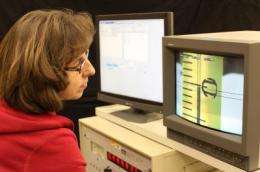NIST researcher Dawn Cross calibrates a mercury thermometer using the icepoint of water as a reference. NIST will cease to offer this service on March 1, 2011, in order to support efforts to reduce the amount of mercury in the environment. Credit: NIST
Beginning March 1, 2011, the National Institute of Standards and Technology will no longer provide calibration services for mercury thermometers. The cessation of the mercury thermometer calibration program marks the end of an era at NIST, which has provided the service since the doors opened in 1901. The closing of the program is part of a larger effort, in collaboration with the U.S. Environmental Protection Agency (EPA) and a number of professional standards organizations and environmental and industry groups, to phase out the use of mercury thermometers altogether.
Mercury is a potent neurotoxin. Elemental mercury is found in thermometers and used in a number of industrial processes such as gold mining. Once released into the environment, mercury makes its way into streams, rivers, and finally the ocean. The mercury is absorbed by sea life and accumulates in the larger fish that humans like to eat. This is the main source of mercury poisoning in humans today.
While many industries follow ASTM standards that stipulate the use of mercury thermometers, these standards have fallen behind the states, many of which have outlawed the sale and transport of mercury thermometers. Presently about 300 of the approximately 700 standards have been amended to allow for the use of both mercury-free liquid-in-glass and digital thermometers.
According to NIST researcher Dawn Cross, each of these ASTM standards is reviewed on a rolling basis. She estimates that all the standards will have been amended to include detailed procedures for making the switch to mercury thermometer alternatives within three years.
"One of our major activities is fielding calls from industry and explaining the science of how they can make the switchover," says Cross. "Change always brings confusion and apprehension, but in every case there is an alternative thermometer to suit the measurement need. It's like learning to use a new cell phone or drive a car with a different kind of transmission; we're simply substituting one technology for another, but they both work equally well."
NIST itself had a stockpile of more than 8,000 industrial-use mercury thermometers hidden away in drawers.
The mercury from these has been sent to specialized recycling centers, which repurpose the mercury to produce compact fluorescent light bulbs. Mercury thermometers contain about 500 milligrams of mercury—an amount equal to the mercury in over 125 compact fluorescent bulbs.
According to Greg Strouse, leader of NIST's Temperature and Humidity Group, that recycling doubly reduces mercury emissions.
"The amount of mercury in a compact fluorescent light bulb is about one to four milligrams," says Strouse. "Most of that mercury is bound to the inside of the glass during the life cycle of the bulb, a process that makes it much less environmentally harmful. Burning of coal is a major source of vaporous mercury released into the atmosphere. Compact fluorescents use less electricity, which reduces the amount of coal burned, which reduces the amount of mercury released by a factor of four."
Provided by National Institute of Standards and Technology


















